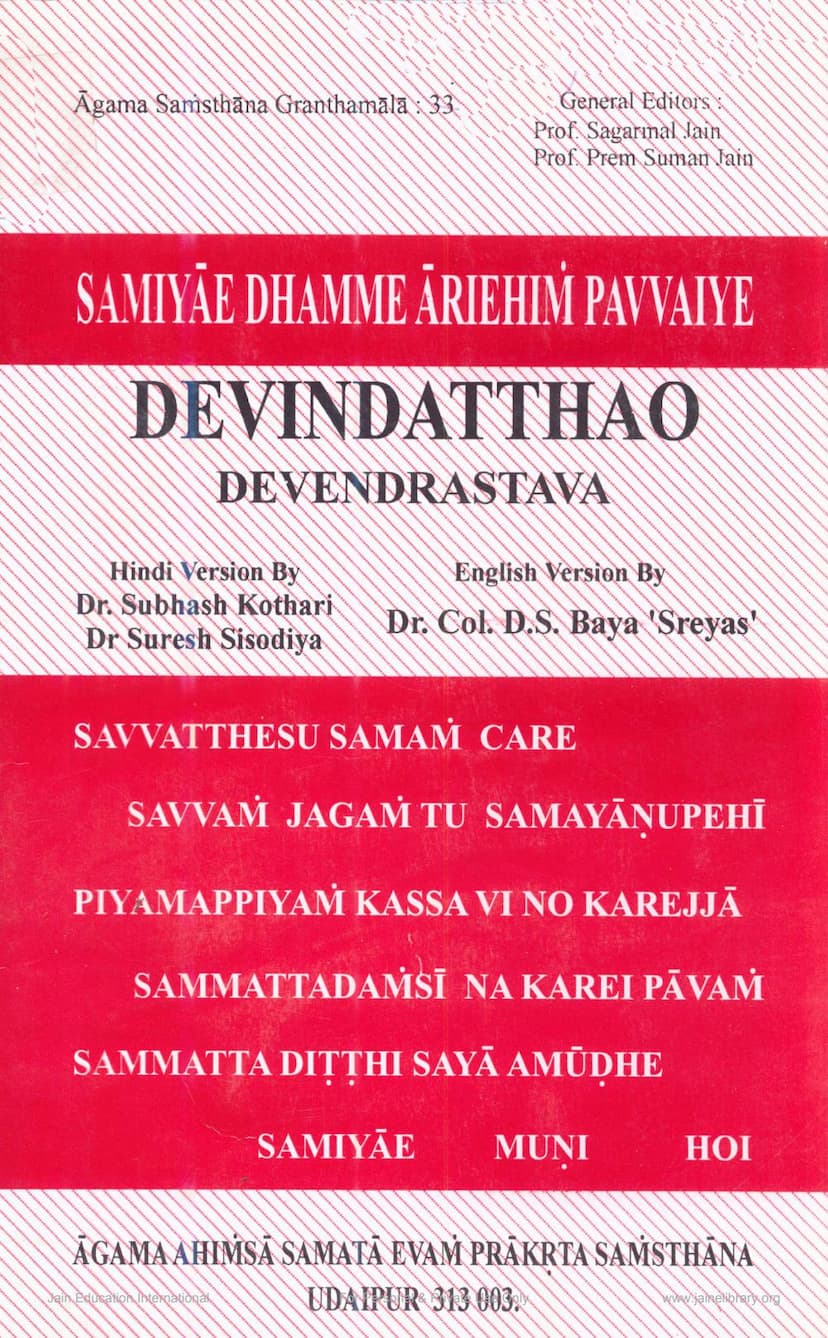Devindatthao Devendrastava
Added to library: September 1, 2025

Summary
The provided text is an English translation of the Devendrastava (also known as Devindatthao), a Jain scripture. Here's a comprehensive summary based on the publisher's notes, translator's note, preface, and the text itself:
Book Title: Devindatthao (Devendrastava) Author: Rsipālita Sthavira (according to internal evidence) Translated into English by: Dr. Colonel D.S. Baya Publisher: Agam Ahimsa Samta Evam Prakrit Samsthan, Udaipur
Overview:
The Devendrastava is a Prakirņaka (miscellaneous canonical text) in the Jain tradition, originally composed in Ardhamāgadhi Prakrit. It is considered an ancient and spiritually significant work. The English translation aims to make this valuable text accessible to a wider, English-speaking audience.
Key Aspects and Content:
-
Nature of the Text: The Devendrastava is primarily a eulogistic composition that describes the cosmology and geography of the Jain universe, focusing on various classes of heavenly beings (gods) and their rulers (Indras). While it contains descriptive elements of these celestial realms, its underlying purpose is to praise the Tirthankaras and establish their supreme glory, as even the most powerful gods bow to them.
-
Structure and Narrative: The text begins with a prologue that includes benedictions to the Tirthankaras, starting from Lord Rsabhadeva to Lord Mahāvīra. The core narrative unfolds as a dialogue between a householder (Śrāvaka) and his wife (Śrāvika). The wife asks detailed questions about the thirty-two Indras (kings of heavenly gods), their abodes, life spans, palaces, powers, and other characteristics. The husband then provides detailed answers based on Jain scriptures.
-
Cosmology and Heavenly Beings: The Devendrastava systematically describes the various classes of heavenly beings:
- Bhavanapati Gods: These are the lowest class of gods, residing in luminous palaces. The text details their twenty Indras (rulers) and their respective palaces, life-durations, and residences across different regions like Jambudvīpa, Manusyottara Mountain, and various seas and islands.
- Vāņavyantara Gods: These are the next class of gods, consisting of eight categories like Piśāca, Bhūta, Rākşasa, etc. The text enumerates their sixteen Indras and their characteristics.
- Jyotişka Gods: These are the celestial bodies that move, namely Moons, Suns, Stars, Constellations, and Planets. The text provides extensive details about their numbers, orbits, speeds, conjunctions, dimensions, and the time durations associated with them. It also explains the waxing and waning of the moon, attributing it to the planet Rāhu.
- Vaimānika Gods: These are the highest order of gods, residing in celestial vehicles (Vimānas). The text describes twelve types of Kalpa-Vaimānika Indras, their abodes, life-durations, and the hierarchy of their heavens. It also discusses Graiveyaka and Anuttara-Vimāna heavens and their inhabitants.
-
Key Themes and Concepts:
- Hierarchy of Beings: The text clearly outlines the hierarchy of existence, from hellish beings to gods and finally to the liberated souls (Siddhas).
- Supernatural Powers: It describes the immense powers and capabilities of the gods and their rulers, illustrating them with examples of how they can influence the universe.
- Cosmic Details: The Devendrastava provides detailed numerical data regarding the number of palaces, vimānas, and the vastness of cosmic distances, reflecting the astronomical and cosmological knowledge within Jainism.
- Bliss of Siddhas: The text concludes by describing the ultimate state of the Siddhas – their eternal, unhindered bliss, their incorporeal nature, omniscience, and their location at the apex of the universe, free from all worldly bonds.
- The Glory of Tirthankaras: A recurring theme is that despite their immense powers, all heavenly gods ultimately bow to and glorify the Tirthankaras, emphasizing the supremacy of spiritual liberation over celestial existence.
-
Authorship and Dating: The preface discusses the authorship of the text, identifying Rsipālita (also transliterated as Ķsipālita) as the author, based on internal evidence in verses 309-310. It also places the composition of Devendrastava around the 1st Century BC, based on linguistic analysis and its mention in ancient texts like the Nandīsūtra and Mūlācāra. The preface also engages in a comparative analysis of the Devendrastava's content with similar descriptions in other Jain canonical works and even touches upon Buddhist cosmology.
-
Translator's and Publisher's Notes:
- The Publisher's Note highlights the importance of Jain Āgamic literature and the efforts of the Agama Samsthana to make it accessible through translations. It expresses gratitude to the translator and others involved in bringing out this English edition.
- The Translator's Note emphasizes the challenges of translating ancient Prakrit texts into English and expresses satisfaction in contributing to the translation of Prakirņakas, a less explored category of Jain literature. It acknowledges the reliance on the Hindi version and the support received.
Significance:
The Devendrastava is significant for understanding the Jain view of the cosmos, the detailed classification of heavenly beings, and the astronomical and geographical concepts prevalent in ancient Jainism. It also offers insights into the development of eulogistic literature within the Jain tradition. This English translation by Dr. Colonel D.S. Baya provides valuable access to this important scriptural text for scholars and the general public alike.